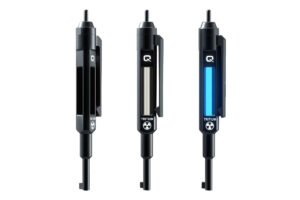

Introducing the New QuiqLite T1 Tritium Tactical Handcuff Key
The QuiqLite T1 Tritium Tactical Hand Cuff Key is the world’s premier handcuff key, designed for law enforcement professionals who demand the highest EDC quality tools available. Featuring a Gaseous Tritium Light Source (GTLS) powered by a rare radioactive isotope of hydrogen, it delivers continuous, reliable illumination in low-light conditions for up to 15-20 years—ensuring you can locate your key when you need it most.
T1 Cuff Key is crafted from hardened stainless steel Ion and houses a Tritium vial insert @ 25mm x 3mm that glows in the dark, making it easy to find or use as a field marker. This first-of-its-kind key features both a shirt clip and key ring attachment, providing versatile carry options for officers in the field. Whether you’re in the line of duty or need a reliable, long-lasting light source for safety and emergency situations, T1 offers the finest crafted handcuff key available – DESIGNED FOR LAW ENFORCEMENT ELITE
PRODUCT FEATURES
- Smallest Gaseous Tritium Light Source
- Requires no External Energy Source
- Delivers Luminescence For Decades
- Includes Shirt Clip and Key Ring Attachment (Interchangeable)
- Temperature Resistant
- 10 Year Light Guarantee
- Maintenance Free
TECHNOLOGY:
Trigalight/Tritium works similar to cathode ray tube, which was once used in television screens. The luminescent coating (zinc sulphide) on the inside of the glass capillaries has the ability to transform the kinetic energy of the electrons into light. The energy is generated by the added tritium gas. The tritium nucleus slowly decays, emitting electrons in the process. When the electrons hit the coating, energy in the form of light is emitted. The color variations of trigalight depend on the diversity of coatings.
FACTS ABOUT RADIOACTIVE TRITIUM
What is tritium?
Tritium is a radioactive isotope of the element hydrogen.
What are the properties of tritium?
Tritium is radioactive and has a half-life of about 12.5 years, which means that half of the radioactive atoms will decay naturally in that time. The Tritium nucleus contains one proton and two neutrons. This makes its atomic nucleus unstable. As a result, one of these neutrons releases electrons and changes into a proton thereby changing from tritium into helium. The electrons emitted are beta rays, a type of radiation. These beta rays are a weak type of radiation that can only travel about 5mm through the air. Although tritium can be a gas under controlled conditions, its most common form is liquid, because, like hydrogen, tritium reacts with oxygen to form water. Like ordinary water, water containing tritium, or tritiated water, is colorless and odorless. Of the three primary types of radiation, alpha, beta and gamma, tritium emits only beta radiation.
What is tritium used for?
The radioactive properties of tritium can be very useful. By mixing tritium with a chemical that emits light in the presence of radiation, a continuous light source is made. This can be applied to situations where a light is needed but where use of batteries or electricity is not practical. Tactical watch faces, Gun sights and now Handcuff Keys are all examples of where this Tritium is commonly used.

External exposure from tritium is not really a concern.
Tritium is weak radiation. When the human body is subjected to radiation, we refer to it as, “exposure.” There are two types of exposure, external and internal. External exposure refers to being subjected to radiation from radioactive materials that exist outside of the body, such as on the surface of the ground or in the air. Internal exposure refers to being subjected to radiation from radioactive materials that have been ingested through the mouth or nose, etc. Since the radiation given off by tritium is very weak and cannot even penetrate our skin, external exposure from tritium is not really a concern.
| Weight | 9 oz |
|---|---|
| Dimensions | 9 × 6 × 2 in |
Be the first to review “T1 Tritium Tactical Cuff Key – White” Cancel reply
Related products
T1 Tritium Cuff Key
The World's Premier Handcuff Key featuring Tritium for Law Enforcement Elite. Coming in 2025. Stay tuned.
T1 Tritium Cuff Key
The World's Premier Handcuff Key featuring Tritium for Law Enforcement Elite. Coming in 2025. Stay tuned.





Reviews
There are no reviews yet.